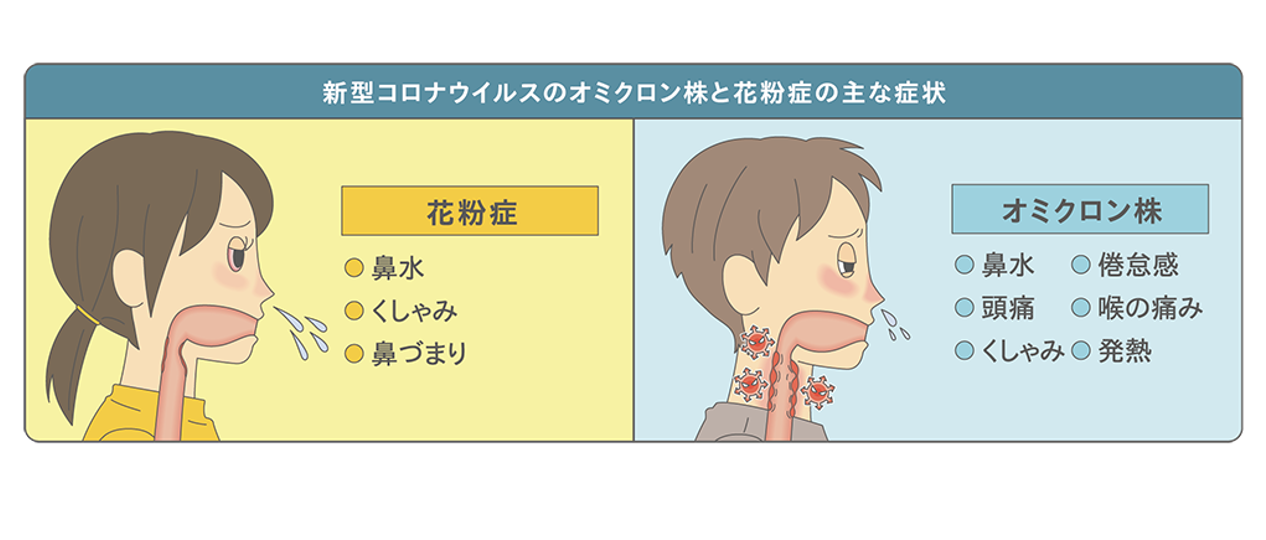ASOURCE®NAVI

公開日:2022.03.08
まもなく本格的な花粉症シーズンを迎えます。花粉で悩む人にとって憂鬱な季節となりますが、今年は新型コロナウイルスのオミクロン株の流行と重なり、花粉症とオミクロン株に感染した場合の症状が似ているため、花粉症の症状があるとオミクロン株に感染しても気づきにくいことが懸念されています。このため、日本耳鼻咽喉科頭頸部外科学会は「花粉症の治療を早めに行い、症状を抑えることが新型コロナウイルスの感染対策の有効な手立てとなる」とアドバイスしています。
ウェザーニュースによると、今年の花粉飛散量は昨年と比べると、北日本や北陸で多く、関東や東海で同程度、西日本では少ない予想です。2月上旬から飛散が始まり、スギ花粉は2月下旬〜3月中旬、ヒノキ花粉は3月下旬〜4月中旬が各地でピークを迎える見込みです。
花粉症とは、スギやヒノキに代表される植物の花粉が原因となるアレルギー症状を指し、原因となる花粉が飛散する時期だけに症状が現れる季節性の病といえます。花粉症の代表的な症状としては、鼻の症状(くしゃみ、鼻水、鼻づまり、ムズムズ感)だけでなく、目の症状(痒み、涙、充血)を伴う場合が多く、喉の違和感、痒み、皮膚の痒み、倦怠感なども現れる場合があります。花粉症は一度発症すると、毎年発症することが多く、症状の現れ方や重症度は人によってさまざまです。
日本耳鼻咽喉科頭頸部外科学会では新型コロナウイルスのオミクロン株に感染した際の症状は鼻水が73%、くしゃみが60%で倦怠感も伴う場合があるとし、花粉症の症状と共通点が多く見分けがつきにくいと報告しています。見分けるポイントとして、専門家は、強い喉の痛みなどがあればオミクロン株の感染の可能性が疑われると指摘しています。また、花粉症の人が新型コロナに感染すると、くしゃみによって周りに多くのウイルスを撒き散らす恐れがあるので、花粉症の治療を早めに行い症状を抑えておくことが重要だと強調しています。

花粉症は、スギなどの花粉が鼻の粘膜から体内に入って起こるアレルギー反応です。人間には、体に細菌やウイルスなどの有害な異物が入ったときに攻撃して排除する免疫機能が備わっています。しかし、本来無害なものを攻撃してしまい、自分の体にとって不都合なことが起きるのがアレルギー反応です。本来、花粉は人間にとって無害ですが、長い期間をかけて体内に蓄積することにより、免疫機能が誤作動して化学反応が起こり、花粉症の症状が引き起こされます。
花粉症の主な治療法としては、症状を内服や点眼薬、点鼻薬などで抑える対症療法と、アレルギー症状を引き起こす物質を少量から体内に投与して体に慣れさせるアレルゲン免疫療法(減感作療法)があります。対症療法でよく用いられるのは、くしゃみや鼻水に効果のある抗ヒスタミン薬や鼻づまりに有効な抗ロイコトリエン薬です。また、鼻症状だけでなく目の痒みにも効果が期待されるステロイド鼻噴霧薬も初期から幅広く使われるようになっています。スギ花粉症に特化したアレルゲン免疫療法として、舌下免疫療法があります。濃度を下げて薄くしたスギ花粉エキスを含む治療薬を舌の下にしばらく含んでから飲みこんで、少しずつ免疫をつくっていく治療法で、すべての人に効果があるわけではありませんが、根治が期待できます。一方で、最低3年間は治療を続ける必要があります。
このほか、内服、点眼薬、点鼻薬など既存の薬物療法で十分な効果が得られず、日常生活や仕事、勉学に支障をきたすような重症な人には注射により抗体医薬を投与する方法もあります。
抗アレルギー薬は、近年開発が進み、1日1回で24時間作用する薬、眠くなりにくい薬、または飲み薬が苦手な方向けの貼り薬など治療の選択肢が増えています。自身のアレルギー反応を起こす花粉が飛ぶ前から内服を開始する予防投薬が非常に有効な手段とされておりますので、早め早めに対策することがおすすめです。
また、コロナ禍での花粉症対策としては、こまめな手洗いやアルコール消毒、マスク着用のほか、メガネやゴーグルの活用も有効とされます。
・花粉情報に注意する
・飛散の多いときの外出を控える
・飛散の多いときは窓、戸を閉めておく
・花粉飛散の多いときは外出時にマスク、メガネを使う
・帰宅時は、衣服や髪をよく払ってから入室する。洗顔、うがいをして、鼻をかむ
・掃除を励行する
・表面がけばけばした毛織物などのコートの使用は避ける
平成22年度厚生労働科学研究補助金免疫アレルギー疾患予防・治療研究事業公益財団法人
日本アレルギー協会事業【的確な花粉症の治療のため(第2版)】より
メディアスグループは、医療機器の販売を中心とした事業を展開しています。医療に携わる私たち(Medical+us)は、医療現場や人々の健康的な明日へ役立つ情報をお届けする情報発信源(Media)の役割も果たしていきたいと考えています。